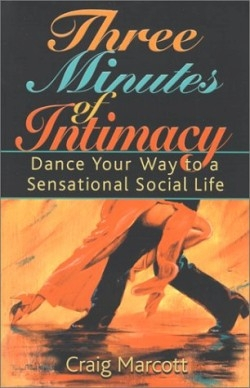Three Minutes of Intimacy
Dance Your Way to a Sensational Social Life
“The sharing of body movements to music, performed with a leader and follower, creates an unparalleled three minutes of intimacy with another human being,” writes Marcott. He asserts that these three minutes can be used to improve one’s social life.
The thesis of the book is that partner dancing is an easy way to meet other people. Dance classes typically require that their members dance with a variety of partners while learning. This gives people the length of a song to introduce themselves to each other and possibly strike up a friendship, or in some cases, the beginning of a romance.
This focus is maintained throughout chapters that also offer basic information on partner dancing, such as where it can be learned and proper etiquette (if you turn someone down for a dance, you shouldn’t then dance that song with another person). One chapter consists of brief overviews of different kinds of dances. Among the descriptions of movement, tempo, and level of difficulty are interesting facts such as Mambo means “voodoo princess” in Haitian Creole and West Coast Swing is the official state dance of California.
Marcott also shares the stories of fellow dancers like Diane, a hesitant woman he talked into coming to one of his club’s dance workshops despite the fact that she didn’t have a partner. “This beats the singles bars any day,” she later told him. “The atmosphere is much more comfortable, and everyone is so friendly! Someone already invited me to go to another dance on Thursday.”
Another new dancer, a beautiful woman named Lisa, attended one of the club’s dances and met Dave. He was a plain-looking man, but had been dancing for a while and offered to give her lessons. Their first dance provided that
noncommittal, three-minute introduction. The following dance lessons extended their knowledge of each other, and today Lisa and Dave are married. Marcott asserts that in other social
situations that don’t have a ready-made ice breaker, Dave may never have had the confidence to walk up and talk to Lisa. With a skill he had confidence in, and could offer to help her with, the initial meeting was easy.
Marcott’s book is written in an easy-going, conversational voice, but still encompasses a good amount of research. An indispensable resource guide at the end tells where to find dance clothes, music, books, videos, Internet sites, and national dance organizations. It even includes a list of dance vacations one can take, such as tours to Buenos Aires to learn the Tango.
The author’s enthusiasm for dance is apparent, and is inspirational for people looking for that extra push to move them onto the dance floor of sociability. Since dancing does take a commitment of time and energy, only those who are willing to invest in it will attain the benefits of an improved social life.
Reviewed by
Christine Canfield
Disclosure: This article is not an endorsement, but a review. The publisher of this book provided free copies of the book to have their book reviewed by a professional reviewer. No fee was paid by the publisher for this review. Foreword Reviews only recommends books that we love. Foreword Magazine, Inc. is disclosing this in accordance with the Federal Trade Commission’s 16 CFR, Part 255.

